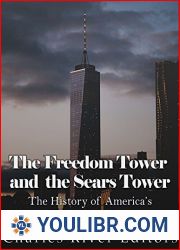
BOOKS - The Freedom Tower and the Sears Tower: The History of America's Tallest Build...


US $5.78

525464

525464
The Freedom Tower and the Sears Tower: The History of America's Tallest Buildings
Author: Charles River Editors
Year: November 26, 2017
Format: PDF
File size: PDF 3.9 MB
Language: English
Year: November 26, 2017
Format: PDF
File size: PDF 3.9 MB
Language: English
*Includes pictures *Includes online resources and a bibliography for further reading *Includes a table of contents Walking around Chicago today, it's easy to forget about its past as a rural frontier, and that's due in no small part to the way Chicago responded to the Great Fire of 1871. Immediately after the fire, Chicago encouraged inhabitants and architects to build over the ruins, spurring creative architecture with elaborate designs, and architects descended upon the city for the opportunity to rebuild the area. Over the next few decades, Chicago had been rebuilt with the country's most modern architecture and monuments, and the Windy City's skyscrapers reached over 20 stories by the early 20th century, but it wouldn't take long for the city to turn its early skyscrapers into things of the past. Burnham's 22 story high Masonic Temple Building, once the tallest building in the world, was demolished in favor of buildings that were twice as tall. Though it's technically named the Willis Tower today, Chicago's landmark is still best known as the Sears Tower, and Sears got a lot of bang for its buck. The Sears Tower only took two years to build at a cost of about $150 million, and it is still the second tallest building in America, a fact Chicagoans sharply debate after the Sears Tower was judged to be shorter than New York City's new Freedom Tower. In 1969, Sears wanted to create a large office space for its employees in the city, and they commissioned the firm Skidmore, Owings and u0026 Merrill to design and build the structure. The firm conceived of the now famous design, in which the first 50 stories of the structure were connected by what are essentially nine separate tube shaped buildings. After the 50th story, seven of the nine tubes rise up to the 90th floor. From there, only two tubes rise to the building's 108th floor. This design gives the Sears Tower the appearance of a large building at ground level that gradually tapers off into a thinner rectangle at the top. It should come as no surprise that in the dark days following the terrorist attacks of September 11, 2001, New York City began searching for some way to demonstrate its recovery and resolve. The obvious way to do just that was to rebuild what had been destroyed. Since there was no way to bring back the lives of those lost, the most straightforward path was to rebuild the Twin Towers that had fallen, but there was more to be done than to just rebuild the lost Twin Towers; the new building was to be bigger, taller, and better than before, as everyone hoped the country would somehow be. In the decade that followed, the first of a new millennium, the Freedom Tower experienced many of the same ups and downs that the nation did. Plans to rebuild it were met with the same level of controversy as those to fight the war on terror. Likewise, its popularity ebbed and flowed with the fickle hearts of a people grown weary with fighting an enemy overseas and a poor economy at home. Political parties rose into and fell out of power, changing again and again the environment in which the builders were trying to work. At some points, it seemed that the project would never end. Fortunately, the building itself finally knew victory and opened to the public, much as it seems the United States has made some inroads in the war against terror. At the same time, there is much left to do on both fronts, as the owners of One World Trade Center continue to try to rent out the space they have created, and those fighting terrorism at home and abroad continue to try to weed out the last vestiges of those who wish the nation ill.














































